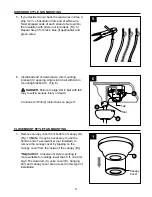
19
OPERATION INSTRUCTIONS
3A. In
warmer
weather, setting the reverse switch
in the
DOWN
position will result in downward
airflow creating a wind chill effect. (Fig. 3A)
3B. In
cooler
weather, setting the reverse switch in
the
UP
position will result in upward airflow that
can help move stagnant, hot air off the ceiling
area. (Fig. 3B)
3C.
IMPORTANT
: Reverse switch must be set
either
completely
UP
or
completely
DOWN
for
fan to function. If the reverse switch is set in the
middle
position (Fig. 3C), fan will not operate.
3A
3B
3C
At least twice each year, lower canopy (B) to check downrod (A) assembly, and then tighten all
screws on the fan. Clean motor housing (D) with only a soft brush or lint-free cloth to avoid
scratching the finish. Clean blades (G) with a lint-free cloth. You may occasionally apply a light
coat of furniture polish to wood blades for added protection.
Important:
Shut off main power supply before beginning any maintenance. Do not use water or
a damp cloth to clean the ceiling fan.
CARE AND MAINTENANCE


































